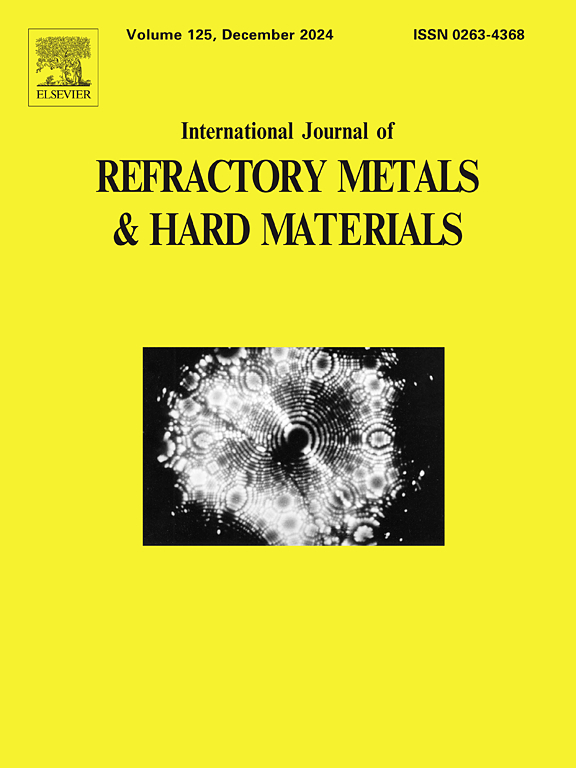Hot deformation behavior and microstructure evolution of WRe alloy under high temperature compression
IF 4.2
2区 材料科学
Q2 MATERIALS SCIENCE, MULTIDISCIPLINARY
International Journal of Refractory Metals & Hard Materials
Pub Date : 2025-01-26
DOI:10.1016/j.ijrmhm.2025.107073
引用次数: 0
Abstract
The hot deformation behavior and microstructural evolution of a powder metallurgy W![]() 25Re alloy have been investigated by conducting hot compression tests in the temperature range of 1670–1870 K and strain rate range of 0.001–0.1 s−1. Based on the experimental results, a constitutive model with a correlation coefficient of 0.974 was established to predict the yield stresses. Furthermore, a hot processing map was constructed in the temperature range of 1670–1870 K and strain rate range of 0.001–0.1 s−1 to determine the optimum hot processing parameters for the W
25Re alloy have been investigated by conducting hot compression tests in the temperature range of 1670–1870 K and strain rate range of 0.001–0.1 s−1. Based on the experimental results, a constitutive model with a correlation coefficient of 0.974 was established to predict the yield stresses. Furthermore, a hot processing map was constructed in the temperature range of 1670–1870 K and strain rate range of 0.001–0.1 s−1 to determine the optimum hot processing parameters for the W![]() 25Re alloy. In addition, the microstructural evolution of the material was analyzed using electron backscatter diffraction (EBSD) and transmission electron microscopy (TEM) techniques. The results indicate that dynamic recovery is the dominant softening mechanism during hot compression. However, the softening effect of dynamic recrystallization becomes more significant with increasing temperature and decreasing strain rate. At deformation temperatures of 1670 K and 1770 K, the alloy exhibited strong 〈100〉// compression direction (CD) and 〈111〉//CD fiber textures. When the deformation temperature is increased to 1870 K, the texture changes from <100>//CD to 〈111〉//CD. The investigation of the thermal deformation mechanism shows that the {123}〈111〉 slip system dominates the thermal deformation process.
25Re alloy. In addition, the microstructural evolution of the material was analyzed using electron backscatter diffraction (EBSD) and transmission electron microscopy (TEM) techniques. The results indicate that dynamic recovery is the dominant softening mechanism during hot compression. However, the softening effect of dynamic recrystallization becomes more significant with increasing temperature and decreasing strain rate. At deformation temperatures of 1670 K and 1770 K, the alloy exhibited strong 〈100〉// compression direction (CD) and 〈111〉//CD fiber textures. When the deformation temperature is increased to 1870 K, the texture changes from <100>//CD to 〈111〉//CD. The investigation of the thermal deformation mechanism shows that the {123}〈111〉 slip system dominates the thermal deformation process.
求助全文
约1分钟内获得全文
求助全文
来源期刊
CiteScore
7.00
自引率
13.90%
发文量
236
审稿时长
35 days
期刊介绍:
The International Journal of Refractory Metals and Hard Materials (IJRMHM) publishes original research articles concerned with all aspects of refractory metals and hard materials. Refractory metals are defined as metals with melting points higher than 1800 °C. These are tungsten, molybdenum, chromium, tantalum, niobium, hafnium, and rhenium, as well as many compounds and alloys based thereupon. Hard materials that are included in the scope of this journal are defined as materials with hardness values higher than 1000 kg/mm2, primarily intended for applications as manufacturing tools or wear resistant components in mechanical systems. Thus they encompass carbides, nitrides and borides of metals, and related compounds. A special focus of this journal is put on the family of hardmetals, which is also known as cemented tungsten carbide, and cermets which are based on titanium carbide and carbonitrides with or without a metal binder. Ceramics and superhard materials including diamond and cubic boron nitride may also be accepted provided the subject material is presented as hard materials as defined above.

 求助内容:
求助内容: 应助结果提醒方式:
应助结果提醒方式:


